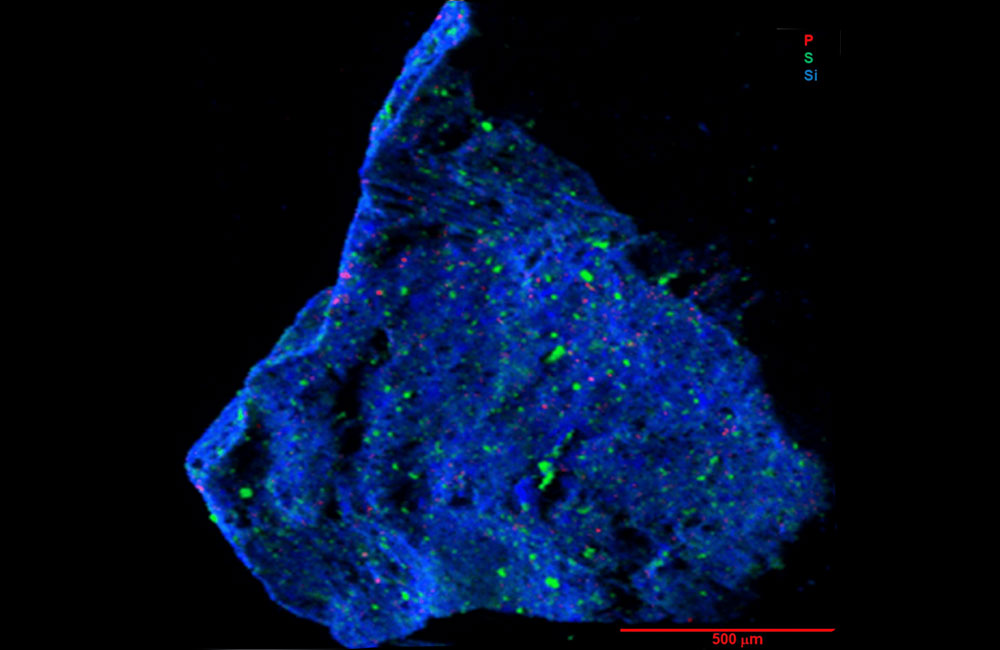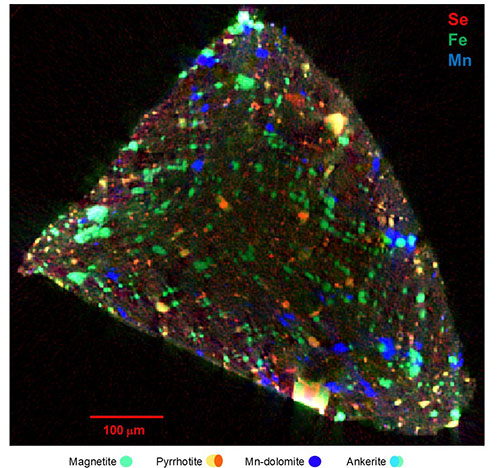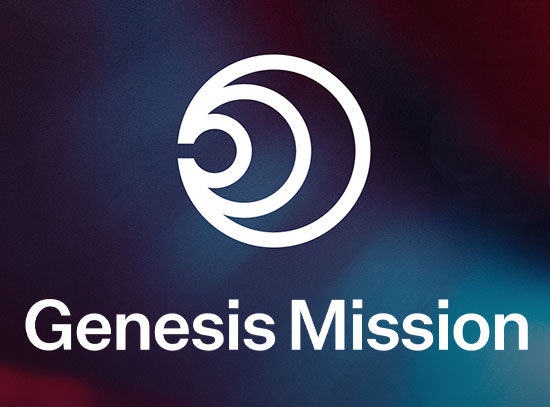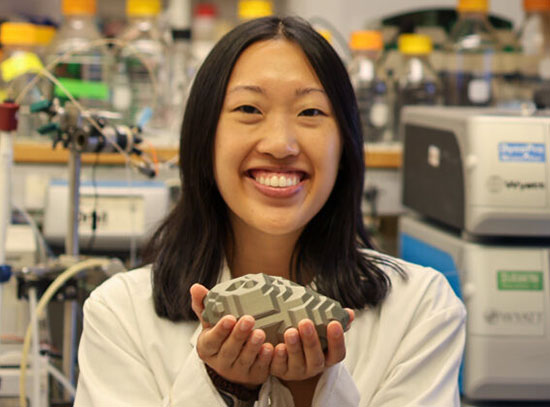Ryugu Asteroid Research Reveals Mineral History Predating Any on Earth
Details of the asteroid's composition may help scientists learn how water and prebiotic organic matter arrived on Earth
August 25, 2025
 enlarge
enlarge
This image shows the chemistry of one of the sample grains as measured at the TES beamline using tender-energy X-ray microspectroscopy, revealing the locations of phosphorus (P, in red), sulfur (S, in green), and silicon (Si, in blue) across the grain's surface.(MDPI/Brookhaven National Laboratory)
In 2020, the Hayabusa2 uncrewed spacecraft successfully returned small fragments from the near-Earth asteroid Ryugu, providing the first pristine samples from a carbonaceous asteroid. Grains from those samples were studied at the National Synchrotron Light Source II (NSLS-II), revealing new details into the asteroid’s composition and origin. This insight could ultimately help answer big questions about how water and organic matter came to exist on early Earth, forming the building blocks of life.
NSLS-II is a U.S. Department of Energy (DOE) Office of Science user facility at DOE’s Brookhaven National Laboratory. This research collaboration includes scientists from Stony Brook University, Brookhaven Lab, the State University of New York at Plattsburgh, the Tokyo Institute of Technology, and Brown University.
The Hayabusa2 mission was run by the Japan Aerospace Exploration Agency (JAXA), launching in December 2014 and touching down on Ryugu in February 2019. On Dec. 6, 2020, the spacecraft performed a fly-by past Earth to drop off hermetically sealed sample capsules that were kept safe by parachutes that deployed after plummeting through the atmosphere. The mission’s goal was to retrieve samples from Ryugu so that scientists could achieve a better understanding of the origin and evolutionary history of primitive, organic-rich asteroids. In turn, this knowledge could tell us more about how our solar system’s planets formed.
 enlarge
enlarge
This image shows the chemistry inside one of the sample grains as measured at the XFM beamline using pink-beam x-ray fluorescence computed microtomography, similar to a medical CT scan, revealing the locations of selenium (Se, in red), iron (Fe, in green), and manganese (Mn, in blue) in a virtual cross-section of a grain. (MDPI/Brookhaven National Laboratory)
Ryugu, which was discovered in 1999, likely originated from a larger proto-planetary body that formed in the frigid outer ranges of the solar system. As such, its makeup would have included water ice and carbon dioxide ice. This body was then mildly heated to nearly 212 degrees Fahrenheit (100 degrees Celsius) by short-lived radioactive elements, melting the ices and mobilizing fluids that interacted with and altered its original mineral and organic components, forming a slew of secondary compounds. These processes not only created novel minerals that are not found on Earth, but catalyzed complex organic molecules such as amino acids, essential building blocks for life. All this happened about 4.7 billion years ago, and the material has been essentially preserved in interplanetary space since then. The samples taken from Ryugu contain the signatures of these processes during the early days of the solar system. Earth is constantly changing, and, over time, its natural processes have erased most of the chemical clues about how the solar system first formed. Asteroids like Ryugu preserve this important piece of the solar system’s history.
Through a highly competitive process, the research group was allocated two tiny pieces of the asteroid: one grain from its surface and the other from the subsurface. At NSLS-II, the team studied the grains using a novel combination of X-ray techniques, which collectively yielded information on the microscale chemistry inside the samples, including the specific elements, how they are distributed, and their local molecular structure. Critically, these X-ray techniques are noninvasive and do not require that such precious samples be physically cut.
As described by project lead Paul Northrup of Stony Brook University, “The beauty of these combined techniques is that we can measure the chemistry of both the exterior and the interior of a sample without damaging it. This is important to preserve such rare and unique samples, especially when hundreds of researchers are competing for access to so little material.”
The studies were conducted at two NSLS-II beamlines, the X-ray Fluorescence Microprobe (XFM) beamline and the Tender Energy X-ray Absorption Spectroscopy (TES) beamline. The group used two X-ray imaging techniques: pink-beam fluorescence computed microtomography at the XFM beamline and tender X-ray energy microspectroscopy at the TES beamline.
“It is a real treat to work with such a well-rounded team of scientists from different backgrounds to characterize materials collected from outer space,” said Ryan Tappero, the lead beamline scientist at the XFM beamline.
The team’s results show that the asteroid grains are composed of a wide array of minerals and compounds containing elements such as selenium, manganese, iron, sulfur, phosphorus, silicon, and calcium.
For example, manganese primarily occurred in the form of manganese-bearing dolomite and ankerite, both carbonate minerals. Iron was present as a sulfide mineral, pyrrhotite, and an oxide mineral, magnetite. Copper was present as a form of copper sulfide. Phosphorus was found in two forms: as the mineral hydroxyapatite, better known as the mineral in teeth and bones, as well as a rare phosphide mineral not found on Earth.
These clues begin to tell a story about the starting materials of the asteroid and their early interactions with fluids. In particular, tracking sulfur in its various forms in the samples is important because sulfur is a major player in fluid chemistry and a component of some organic compounds.
In total, the results suggest that there were multiple stages of fluids that altered the asteroid. This information helps to better define the sequence of fluid activity and processes that led to the current composition of Ryugu and other carbonaceous asteroids.
More recently, NASA’s OSIRIS-REx mission returned with samples collected from a different carbonaceous asteroid, Bennu. This same research group is looking forward to comparing these new samples to Ryugu using the imaging beamlines at NSLS-II.
This research was funded by NASA and DOE. It was published in the April 19, 2024, issue of Geosciences.
Brookhaven National Laboratory is supported by the Office of Science of the U.S. Department of Energy. The Office of Science is the single largest supporter of basic research in the physical sciences in the United States and is working to address some of the most pressing challenges of our time. For more information, visit science.energy.gov.
Follow @BrookhavenLab on social media. Find us on Instagram, LinkedIn, X, and Facebook.
2025-22568 | INT/EXT | Newsroom









